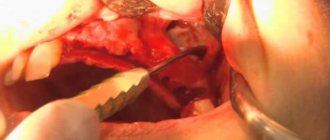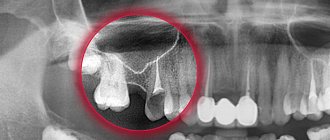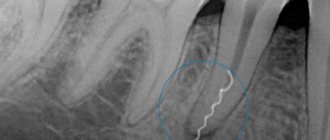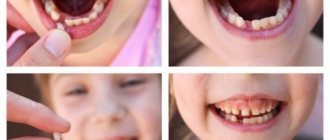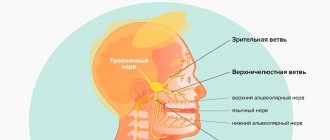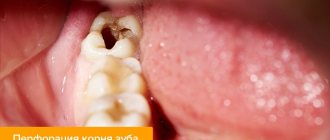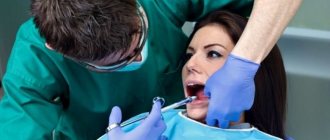Why does my head hurt after tooth extraction?
Tooth extraction is an operation in which the integrity of the gums is disrupted. After it, a hole remains, and during the intervention, blood vessels, nerves, and soft tissues are damaged. It is important that complete healing can take up to 7 days. Over time, the patient may experience pain during meals, as well as during the day. Discomfort often extends not only to the damaged area, but also to the entire surface of the head.
It is considered normal if the hole gradually decreases and the pain becomes less intense. If it remains acute, inflammation on the gums increases, additional symptoms appear - this may indicate the development of complications. Some of them occur directly during surgery:
- an overly branched system of tooth roots, which leads to tissue trauma, including jaw bones;
- a large tooth, after the removal of which a wide hole remains - the recovery period is the longest after the extraction of wisdom teeth;
- the presence of an abscess under the root of the tooth - to remove the pus and clean the abscess cavity, it is necessary to cut the gum;
- insufficient surgical access, as a result of which fragments of dental tissue, cotton wool and other materials may remain in the hole - this leads to inflammation and suppuration.
Postoperative complications are also distinguished. They occur a few days after tooth extraction and are accompanied by intense toothache and headache. It is important to seek medical help promptly and begin treatment.
Alveolitis
Alveolitis is an infectious inflammation of the postoperative socket. It can be caused by staphylococci, streptococci and other pathogenic microorganisms. It is important that they are found in large quantities in the oral cavity, so it is important to carefully treat the wound. Alveolitis is accompanied by characteristic symptoms:
- acute toothache and headache;
- redness and swelling of the gums;
- increased temperature;
- weakness, muscle aches.
One of the common causes of alveolitis is the removal of a blood clot, which is normally located in the wound in the first few days. It is not recommended to remove or move it, since it protects the open wound from pathogenic microorganisms. In addition, inflammation can occur due to poor wound treatment. At the first signs of alveolitis, it is important to consult a dentist for socket sanitation and anti-inflammatory therapy. Lack of treatment can lead to osteomyelitis - this is a dangerous disease that causes destruction of the jaw bones and infection in the bloodstream.
Dry socket
Dry socket is a common complication, especially after wisdom tooth extraction. It is diagnosed when a blood clot is removed prematurely, exposing an open wound, damaged tissue and even bone. This leads to the entry of pathogenic microflora and purulent inflammation. If the blood clot is removed on its own within the first 5 days, cotton wool or gauze soaked in an antibacterial solution is placed in the hole. This will help avoid purulent complications, acute pain and prolonged wound healing.
Inflammation of the trigeminal nerve
The trigeminal nerve is the largest of the 12 pairs of cranial nerves. Its branches are involved in the innervation of the upper and lower jaws, facial muscles, as well as the eye and forehead areas. Trigeminal neuritis is a dangerous disease that is accompanied by acute pain and other characteristic symptoms:
- sensation of pulsation along the nerve, in the temples and eyes;
- numbness, impaired sensitivity of the skin and facial muscles;
- spasms of the masticatory muscles;
- involuntary muscle contractions, especially with severe pain.
Inflammation of the trigeminal nerve can be caused by infection in the tooth socket after its removal. A typical symptom is an exacerbation of pain, pulsation in a certain position, during chewing and talking, when turning or tilting the head. As a result, the patient tries not to touch the damaged area and make a minimum number of movements. Anti-inflammatory, analgesic, and antibacterial therapy is used to treat neuralgia. If necessary, fragments that cause compression (squeezing) of the nerve are removed.
Hematomas
During surgery, blood vessels are damaged, causing blood to leak into surrounding tissue. Hematomas quickly resolve on their own, but in the first few days they can be large and cause severe headaches, redness and inflammation of the gums. However, their condition must be monitored - normally, the hematoma decreases in size or completely disappears in 3-5 days.
Flux
Flux is a purulent inflammation of the periosteum, one of the likely complications. When it appears, swelling and enlargement of the gums occur, and acute toothaches and headaches are observed. Purulent inflammation provokes redness of the surrounding tissues, an increase in local and general temperature, and shooting pain. Flux requires immediate treatment, as it can cause pus and microorganisms to enter the bloodstream, inflammation of the trigeminal nerve, destruction of the jaw bones and other isolated complications.
Swelling in the face and neck
After surgery, swelling of the soft subcutaneous tissues and lymph nodes may be observed. This is a normal reaction of the body, since tissues and blood vessels are injured during tooth extraction. In addition, during the rehabilitation period, immune defense mechanisms are activated - they prevent the proliferation of pathogenic microorganisms and the development of purulent inflammation. In the first few days, swelling of the face and neck can cause constant headaches. They are dull, of varying degrees of intensity, but disappear after swelling decreases.
Gum inflammation
At first, the patient does not have any noticeable sensations after the operation. However, after some time, the gums may begin to bleed, fever may occur, and the tooth will become loose and loose in the gum. The pain often radiates to the ear. It is important to start treatment promptly, otherwise an abscess or fistula filled with pus may form. You can’t wait for it to fester - the sooner treatment is started, the greater the chance that complications will be avoided.
If pulpitis occurs, the pain radiates to the ear and also to the temple. With this manifestation, it is better to take a pain reliever.
You should not rely on self-medication with traditional medicine - they can further aggravate the situation, since the root cause of inflammation is clear only after examination by a dentist.
Important ! Auxiliaries treat the symptoms, not the cause of the pain.
If you treat symptoms while ignoring the cause of their occurrence, you can start the development of the disease to such an extent that you will have to remove a previously healthy tooth.
Time frame for complete healing after tooth extraction
It is important to understand that tooth extraction is a full-fledged dental operation, after which a period of rehabilitation is required. During this time, the hole heals, pain decreases and the injured area of the gum is restored. There are several main stages:
- The first week after surgery is the period during which the hole is completely filled with granulation tissue. In the first days, a blood clot forms, and on days 4–5, normal granulation forms on top of it. Soreness, swelling, and redness begin to decrease normally within 3–4 days.
- Second week – the recovery process continues. On the 8th day, headaches and toothaches completely disappear, the local temperature of the gums normalizes, and the tooth socket heals. On days 10–14, the process of bone tissue restoration begins.
- The next 1–2 months are the period when intensive growth of bone tissue occurs. It completely fills the hole. However, the bone will become sufficiently strong no earlier than 5–6 months after tooth extraction.
The duration of rehabilitation depends on many features. So, molars have larger roots, which may have an irregular structure, so when they are removed, a large hole remains. Recovery can be lengthy even after removal of incisors or fangs if a cyst or abscess is discovered. It is important to monitor your well-being, but headaches in the first week after surgery are considered a normal reaction of the body.
Therapy for pain
If there is unpleasant pain radiating to the ear, the patient should not worry ahead of time. It usually goes away after two or even three days.
It is extremely important to contact specialists in whose work you can be confident. Treatment is carried out by qualified doctors in specialized medical institutions. Self-medication and traditional medicine methods can do more harm than good.
When contacting a doctor, be sure to notify him of any drug or other intolerance or allergic reactions. The doctor can select the necessary drug substitute to facilitate therapy. Don't forget to tell your doctor what medications you are taking (regularly and during the week before your appointment).
The dentist will indicate a list of recommendations that must be carefully followed in order to avoid complications.
You should not rinse your mouth, while brushing your teeth, you should not touch the socket with a brush or dental floss, food should be warm and without a lot of salt and spices. These rules must be followed for at least two days after the intervention. Compliance with them will help avoid serious and unpleasant consequences.
People suffering from diseases such as chronic hepatitis, diabetes mellitus, severe liver damage, and HIV infection should pay special attention to their health. In these conditions, there are disturbances in the functioning of the immune system, which is why various kinds of complications arise after any surgical interventions. To avoid this, it is necessary to carry out a course of antibiotic treatment under the guidance of the attending physician.
For three days, any alcohol and soda are completely excluded. You only need to chew soft food on the side opposite to the extracted tooth, so as not to touch the wound.
Take painkillers prescribed by your doctor. To avoid increased pain at night, it is recommended to sleep on the side where the tooth was removed.
Methods for diagnosing and treating headaches
When diagnosing, it is important to understand whether the headache was provoked by tooth extraction or whether it was present in the patient before the operation. To do this, a comprehensive examination is carried out, which will include an examination by a dentist and other specialized specialists. Headaches after tooth extraction must be distinguished from trigeminal neuralgia, migraines, traumatic brain injuries and their consequences, and hypertension. An X-ray or MRI of the jaw may be needed to confirm the diagnosis. The images will show dental fragments, cysts and abscesses, as well as other factors that can lead to severe headaches.
The Clinical Brain Institute has all the conditions to undergo a full examination and receive a complete treatment regimen for various cases of headaches. To treat pain in the head and jaw after tooth extraction, the following techniques may be required:
- antibacterial therapy - used to cleanse the wound of pathogenic microflora, as well as to prevent bacteria from entering the wound;
- local drugs with anti-inflammatory and analgesic effects;
- if necessary, socket tamponade;
- surgical techniques - removal of pus and dental fragments, as well as other foreign substances that can provoke an inflammatory reaction and pain.
The basic principles of therapy after tooth extraction are monitoring the proper restoration and healing of the hole, sanitation of the oral cavity and treatment of the open wound from pathogenic microorganisms. If there are complications, including trigeminal neuritis, additional comprehensive treatment will be required. You should consult a doctor if pain and inflammation, swelling and redness of the gums do not decrease within 7 days, and a feeling of throbbing appears. Discomfort in the first week, including headache, is within normal limits.
Pain as a result of tooth extraction
Pain in the jaw and adjacent tissues, radiating to the throat or ear, is a fairly common complaint. However, there is no reason to worry - this phenomenon is considered normal during a very painful process. Damage to nerves, tissues, and mucous membranes leads to open wounds. In this regard, pain arises, which is of a natural nature and manifests itself until recovery.
Important ! As a rule, the pain goes away within a couple of days.
If you have such symptoms, doctors recommend taking anesthetics (it’s better to ask your dentist which ones are right for you) and wait until the pain goes away.
Prevention methods
Tooth extraction is often required when the 3rd molar (molar) is out of position. However, surgery is also prescribed for caries, abscesses and cysts, and injuries. To prevent caries, you should pay enough attention to oral hygiene, undergo regular dental checkups and clean the enamel from plaque and tartar. Immediately after surgery, it is important to observe several conditions that will help avoid complications and headaches:
- use disinfectant solutions for the oral cavity - they clean the wound from pathogenic microflora;
- take only soft, liquid food in the first few days, so as not to further injure the socket;
- Do not remove a blood clot from the postoperative socket yourself, but if it falls out, consult a doctor.
At the Clinical Brain Institute, you can undergo all the necessary examinations, determine the exact cause of the headache and receive a competent treatment regimen. Our center employs only experienced specialists, general and specialized doctors, as well as modern, precision equipment. There are all conditions for quick and high-quality diagnosis, regular examinations, as well as outpatient and inpatient treatment of headaches.
Clinical Brain Institute Rating: 5/5 — 1 votes
Share article on social networks
The appearance of bleeding
Immediately after the removal procedure, bleeding appears from the hole. This is quite normal, since the vessels are damaged, of which there are a lot where the teeth are located. After the operation, the doctor takes the necessary actions to stop the bleeding. Sometimes, unfortunately, there are cases where even after several hours the bleeding still stops. Under this condition, the patient applies a tampon to the gum at the site of the extracted tooth and lightly presses it. This should help, but if it does not work, further consultation with a specialist is necessary.
Traditional medicine for ear pain
There are the following folk remedies that can alleviate the condition when ear pain occurs. However, you should not use them without consulting a doctor - they can help well along with the prescribed therapy.
- Aloe or a leaf of pelargonium (geranium) is wrapped in a clean cloth or gauze, crushed to release the juice, and inserted into the ear canal.
- You can drip onion juice or olive oil in small quantities into your ear.
- Before meals, drink lingonberry decoction. To prepare it, a handful of berries are infused in two glasses of boiling water.
- When otitis is diagnosed, you can use celandine tincture as an addition to the main treatment. To prepare it, mix celandine and vodka in the proportion of 20 g of celandine per 100 g of vodka, leave in a cool place protected from light for 10 days. Afterwards they filter. This infusion is applied to a cotton swab and placed in the sore ear.
Here's what they recommend doing if you have a toothache (after visiting a doctor, of course).
- Mix a dry collection of chamomile and sage, five tablespoons per glass of hot water, and simmer in a water bath for about 30 minutes. Strain, cool and use for rinsing.
- Plantain juice or infusion - brew in boiling water in the same way (about 1 tablespoon per glass), use for rinsing the mouth. The juice from fresh leaves can be applied to sore gums in the affected area.
Interestingly, people also use a remedy for toothache such as wearing garlic on the wrist. To do this, a garlic clove needs to be ground or finely chopped and tied with a bandage on the inside of the wrist to the hand opposite to the diseased tooth. The effectiveness of this method is explained by the fact that garlic, similar to acupuncture, stimulates bioactive points and, acting on them, reduces the intensity of pain. The main thing to remember is that if itching or severe burning or redness occurs, you need to rinse the skin on your hand well and do not use this method again.
If you have agave growing at home, you can use it as a pain reliever. To do this, the agave leaf is washed well, cut and applied to the diseased tooth. However, this method must be used with great caution - agave is considered a poisonous plant that causes allergic reactions, so you can keep this compress for no longer than 5 minutes.
Therapy for the appearance of “dry socket”
As we have already mentioned, during the normal course of the recovery process after extraction, the formation of a blood clot should occur, which performs protective functions and helps rapid tissue regeneration. If it is washed out or damaged, a “dry socket” appears. This happens when eating solid food that can injure the mucous membranes, as well as when rinsing.
In such cases, the attending physician usually prescribes the application of compresses with antiseptic and healing medicinal compositions that accelerate healing.
